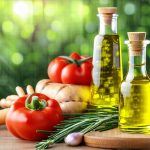The quest for optimal nutrition isn’t simply about what we eat, but fundamentally about how we prepare it. Many conventionally accepted cooking methods, while undeniably convenient and often delicious, can inadvertently diminish the nutritional value of our food and even contribute to digestive discomfort for some individuals. This stems from factors like prolonged heat exposure, excessive water usage, and alterations in cellular structure that impact vitamin stability, enzyme activity, and the bioavailability of essential nutrients. Understanding the interplay between cooking techniques, nutrient retention, and digestive health allows us to make informed choices in the kitchen, ensuring we reap maximum benefit from every meal. It’s about finding a balance – preserving vital elements while creating palatable and enjoyable dishes.
Furthermore, individual digestive sensitivities vary greatly. What one person tolerates effortlessly might cause bloating, gas, or other issues for another. Certain cooking methods can exacerbate these sensitivities by increasing the difficulty our bodies have in breaking down food components. For example, tough-to-digest proteins become easier to process with proper preparation, while excessive fiber, though generally beneficial, can be problematic if not accompanied by adequate hydration and gentle cooking techniques. This article will explore how we can adapt our cooking practices to maximize nutritional value and minimize digestive irritation, leading to a more comfortable and nourishing eating experience for everyone. You might also find insights in neutralizing ingredients that further ease discomfort.
Optimizing Cooking Methods for Nutrient Retention
Nutrient loss during cooking is inevitable – some degree of degradation occurs with almost any method. However, the extent of this loss can be significantly minimized by choosing techniques that are gentler on food. High heat and prolonged exposure to water are two primary culprits. Water-soluble vitamins (like B vitamins and vitamin C) are particularly vulnerable, leaching out into cooking water or being destroyed by excessive temperatures. Similarly, delicate phytonutrients can degrade with intense heating. The goal is not to eliminate all nutrient loss, but rather to reduce it as much as possible.
Steaming, for instance, is a superb method for preserving nutrients. It utilizes minimal water and relatively low temperatures, safeguarding vitamins and minerals. The food isn’t directly immersed in water, reducing leaching. Similarly, stir-frying—when done quickly over high heat with minimal oil—can retain many nutrients because of the short cooking time. Another excellent technique is roasting, especially for vegetables. Roasting concentrates flavors while minimizing nutrient loss compared to boiling, as it doesn’t require submerging food in water. When preparing meals, consider cooking patterns that protect vital nutrients.
Consider these points when choosing a method:
– Shorter cooking times generally equate to greater nutrient retention.
– Lower temperatures are kinder to heat-sensitive vitamins.
– Minimizing water usage reduces leaching of water-soluble nutrients.
– Leaving skins on fruits and vegetables (where appropriate) preserves fiber and phytonutrients.
Gentle Approaches for Enhanced Digestibility
Beyond nutrient preservation, cooking methods play a crucial role in making food easier to digest. Some individuals struggle with certain textures or components, leading to discomfort. For example, cruciferous vegetables like broccoli and cauliflower can cause bloating due to their raffinose content – complex sugars that are difficult to break down without proper preparation. Similarly, legumes contain oligosaccharides which require enzymatic breakdown for optimal digestion. The key is to soften fibers and begin the digestive process before food reaches your gut.
One effective strategy is pre-soaking legumes before cooking. This helps reduce their raffinose content and makes them more digestible. Similarly, lightly steaming or sautéing cruciferous vegetables can deactivate myrosinase, an enzyme that contributes to gas production. Furthermore, combining foods strategically can aid digestion. For example, pairing fiber-rich foods with healthy fats slows down digestion, allowing for better absorption of nutrients and reducing the likelihood of rapid fermentation in the gut. Finally, incorporating digestive spices like ginger, turmeric, and cumin into your cooking not only adds flavor but also supports digestive function by stimulating enzyme production and reducing inflammation. You could explore comfort-centered meals designed for easier digestion.
The Art of Tenderizing Proteins
Proteins can be notoriously difficult to digest if they aren’t properly prepared. Tough cuts of meat require extensive chewing, placing a burden on the digestive system. Marinating is an excellent technique for tenderizing proteins – acids in marinades (like lemon juice or vinegar) break down muscle fibers, making them easier to chew and digest. Furthermore, slow cooking methods, such as braising or stewing, are incredibly effective at transforming tough cuts into melt-in-your-mouth tenderness. Preparing and seasoning can also minimize acid formation.
Here’s a step-by-step guide for braising:
1. Sear the meat on all sides to develop flavor.
2. Add liquid (broth, wine, or water) to partially submerge the meat.
3. Cover and simmer over low heat for several hours until tender.
Another method is using pressure cooking which drastically reduces cooking time while achieving similar results – it utilizes high pressure to break down tough fibers efficiently. For plant-based proteins like beans and lentils, thorough cooking is essential. Overcooked legumes are much easier to digest than undercooked ones, as the heat breaks down their complex sugars.
Soothing Vegetable Preparation Techniques
Many individuals experience digestive distress from raw or improperly cooked vegetables. This can be due to high fiber content, presence of indigestible carbohydrates (like raffinose in cruciferous vegetables), or simply the structural rigidity of plant cell walls. Gentle cooking methods help break down these components, making vegetables more accessible to digestive enzymes. Light steaming is ideal for preserving nutrients while softening fibers.
- Steaming broccoli for just 5-7 minutes can significantly reduce its gas-producing potential.
- Roasting root vegetables (like carrots and sweet potatoes) not only enhances their flavor but also breaks down their starches, making them easier to digest.
- Pureeing cooked vegetables creates a smoother texture that requires less effort from the digestive system.
Consider incorporating healthy fats when preparing vegetables. Fat-soluble vitamins are better absorbed with fat intake, and the presence of fat slows digestion, aiding in nutrient absorption and reducing bloating. You can also learn about cooking techniques to further reduce digestive burden.
Harnessing Fermentation for Digestive Support
Fermented foods – like yogurt, kefir, sauerkraut, and kimchi – are naturally rich in probiotics, beneficial bacteria that support gut health and aid digestion. The fermentation process itself pre-digests some of the food components, making them easier to absorb and reducing digestive strain. Furthermore, fermented foods contain enzymes that assist in breaking down complex carbohydrates and proteins.
You can easily incorporate fermented foods into your diet:
1. Add a small serving of yogurt or kefir to your breakfast.
2. Include sauerkraut or kimchi as a side dish with meals.
3. Experiment with making your own fermented vegetables at home – it’s a surprisingly simple process!
However, introduce fermented foods gradually, as rapid introduction can sometimes cause temporary digestive upset. Listen to your body and adjust intake accordingly. Remember that the benefits of fermentation extend beyond digestion – they also contribute to immune function and overall health. Learning breathwork techniques can also support healthy digestion.


















